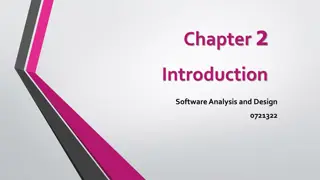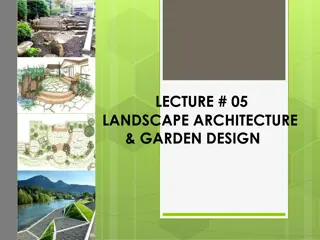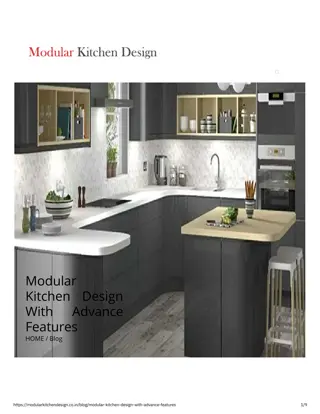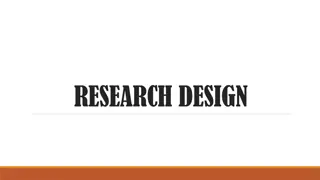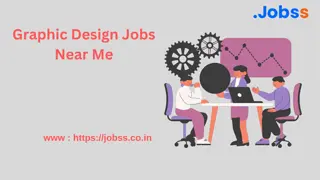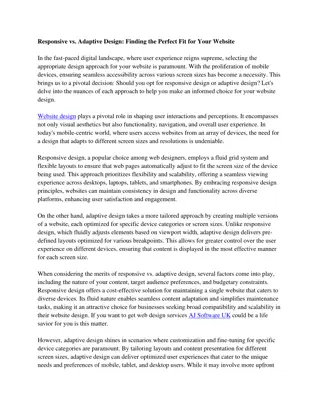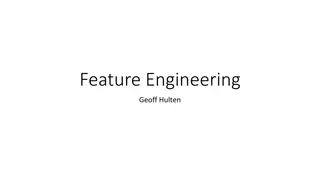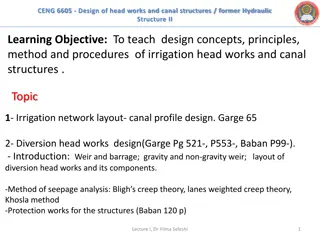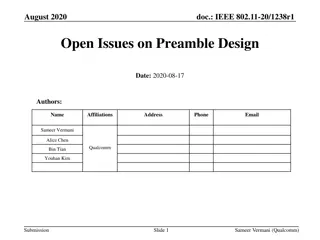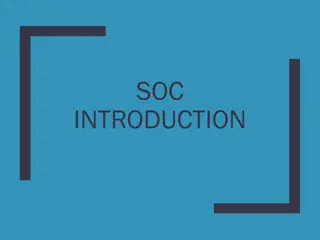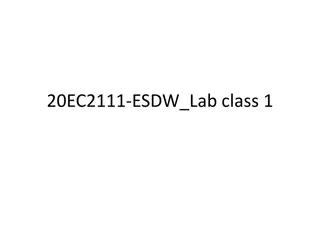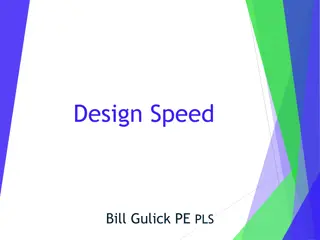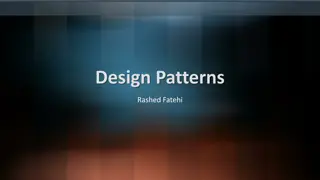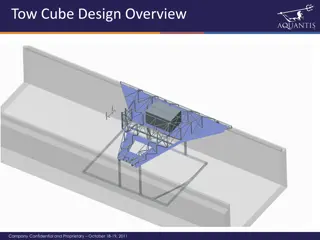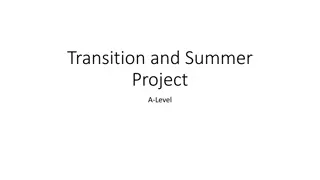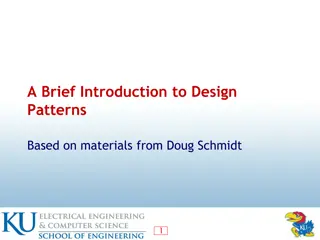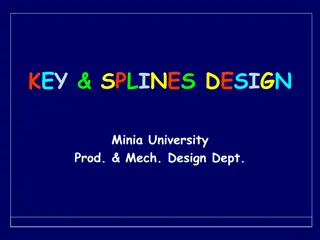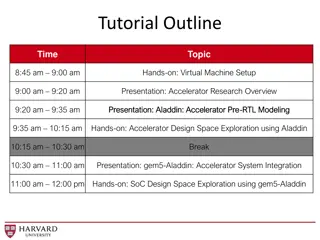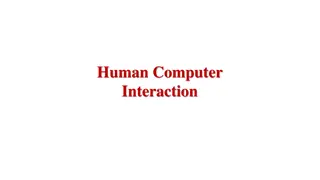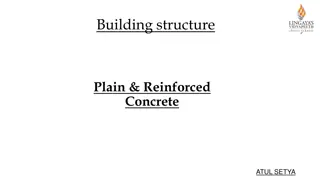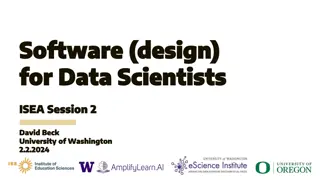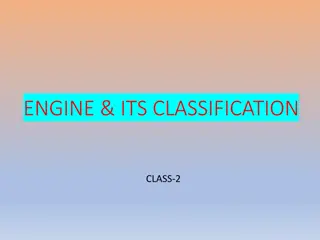GCSE Design Technology Knowledge Organiser and Course Structure Overview
In this detailed knowledge organiser, find information about the GCSE Design Technology course structure, learning objectives, mission statement, and core technical principles for KS4 students. The course emphasizes iterative design cycles, creative thinking, problem-solving, and addressing environm
7 views • 53 slides
Software Analysis and Design Process
Software analysis and design involve a systematic approach to understanding user requirements, creating logical models, and transitioning to detailed design specifications. Requirements analysis focuses on capturing system requirements, while design translates these requirements into implementation
8 views • 16 slides
LECTURE # 05 LANDSCAPE ARCHITECTURE & GARDEN DESIGN
Landscaping involves modifying land features to create aesthetic and functional outdoor spaces. Landscape architecture blends ancient garden design with modern practices to shape man-made environments. The profession encompasses urban design, site planning, environmental restoration, and parks devel
2 views • 18 slides
Textil School for Design, Technology, and Management - Overview
The Textil School for Design, Technology, and Management is a renowned institution funded by the European Union. Offering undergraduate applied studies in Textile and Apparel Design, Textile Engineering, and Management in the Textile Industry, the school focuses on artistic expression, modern method
0 views • 16 slides
Temporary Storage Facility Design Concept Overview
Technical presentation on the design concept of a Consolidated Interim Storage Facility for spent nuclear fuel and high-level radioactive waste. The concept includes a reference design, independent cost estimates, and site plan details for potential host communities. The design features cask-on-a-pa
0 views • 21 slides
Modular Kitchen Design With Advance Features
With its innovative features that make cooking simpler and rooms cleaner and more effective, modular kitchen design plans are like heroes in the world of interior design. These smart, fashionable, and extremely effective kitchens are not normal places to cook. Every feature, from modern appliances t
2 views • 4 slides
Research Design: Key Concepts and Features
Research design is the blueprint that guides researchers in collecting and analyzing data, ensuring objectivity, reliability, validity, and generalizability. It involves a structured plan throughout the research process to obtain answers to research questions effectively. This article explores the d
0 views • 11 slides
If you are searching for Architectural Design in Takapūwāhia
If you are searching for Architectural Design in Takap\u016bw\u0101hia, At HWA - Architecture, we bring years of experience in Architectural Design to projects across New Zealand. With ongoing projects in Otago, Canterbury, Waikato, Kapiti, and Horowhenua, we have established ourselves as a trusted
1 views • 6 slides
Exploring Graphic Design Jobs Near Me: Opportunities and Insights
\n In today's visually-driven world, graphic design plays a crucial role in shaping the identity and communication of businesses, organizations, and brands. From logos and branding materials to digital assets and marketing collateral, the demand for skilled graphic designers continues to grow. If yo
1 views • 9 slides
Responsive vs. Adaptive Design: Finding the Perfect Fit for Your Website
In the fast-paced digital landscape, where user experience reigns supreme, selecting the appropriate design approach for your website is paramount. With the proliferation of mobile devices, ensuring seamless accessibility across various screen sizes has become a necessity. This brings us to a pivota
1 views • 2 slides
Guidelines for Design of Cement Concrete Pavement and Interlocking Paver Blocks
This document provides guidelines for designing cement concrete pavements and interlocking paver blocks, covering factors governing design, wheel loads, design period, subgrade characteristics, approximate k values based on CBR values, and the importance of a sub-base below concrete pavements. It em
0 views • 67 slides
Feature Engineering in Machine Learning
Feature engineering involves transforming raw data into meaningful features to improve the performance of machine learning models. This process includes selecting, iterating, and improving features, converting context to input for learning algorithms, and balancing the complexity of features, concep
1 views • 28 slides
Software Engineering Design Principles and Concepts
The chapter discusses the essential principles and concepts in software design, highlighting the four key design models - data design, architectural design, interface design, and component-level design. It emphasizes the importance of traceability to the analysis model, minimizing the gap between so
2 views • 36 slides
Design of Head Works and Canal Structures - Learning Objectives and Evaluation
This course covers the design concepts, principles, methods, and procedures related to the design of irrigation head works and canal structures. Topics include irrigation network layout, diversion head works design, seepage analysis methods, protection works, canal profile design, canal head regulat
0 views • 4 slides
IEEE 802.11-20/1238r1 Preamble Design Open Issues
Proposed designs addressing preamble design issues in IEEE 802.11-20/1238r1 include U-SIG content and overflow for Unified SU/MU PPDU, EHT-SIG design, and punctured channel indication. The focus is on conveying puncturing patterns efficiently while minimizing signaling overhead. The design features
5 views • 32 slides
Fashion Choices and Design Features
Delve into the world of fashion choices and design features, from factors influencing clothing selection to the importance of color, pattern, texture, and shape in garment design. Discover how individual preferences, lifestyle, and societal influences shape our clothing decisions, and learn to expre
0 views • 19 slides
System on Chip (SoC) Design and Components
Explore the world of System on Chip (SoC) design, components, and working flow. Learn about Intellectual Properties (IP), platform-based design, typical design flows, top-down design approach, and the emerging Electronic System Level (ESL) design flow. Discover the essential components of an SoC, su
0 views • 45 slides
Design Inspiration and Elements in Costume and Fashion Design
Dive into the world of costume and fashion design through a visual journey of finding design inspiration, understanding the design process, emphasizing originality, and exploring different sources of creativity. Discover how technology, art, food, history, architecture, and nature can spark innovati
0 views • 45 slides
Enhancing Piping Design Efficiency with Spec-Driven Technology
Explore how Spec-Driven Piping technology powered by CADACTIVE offers a standardized approach for piping design in Creo Parametric. This innovative extension streamlines design communication, eliminates errors, and improves design efficiency by utilizing a master catalog, automated checking capabili
0 views • 15 slides
Material Design: Combining Classic Design Principles with Technological Innovation
Material Design is a design language that combines traditional design principles with the possibilities offered by technology and science. It emphasizes visual language, classic design elements, and innovation to create delightful user experiences. The Material Metaphor, Imagery, Typography, Color,
0 views • 34 slides
Electronic Design Automation with Proteus Software Suite
Dive into the world of electronic design automation with the Proteus Design Suite, a powerful software tool primarily used by engineers and technicians to create schematics and printed circuit boards. Learn about the software's features, installation procedures, and PCB design capabilities, along wi
0 views • 22 slides
Comprehensive Guide to System Design Components and Techniques
System design involves the detailed planning and identification of components in an information system, aiming to provide users with a general understanding of the new system. This process includes techniques like flowcharts, prototyping, and component design, covering aspects such as output design,
0 views • 24 slides
Design Speed in Highway Engineering
Design speed in highway engineering refers to the selected speed used to determine the geometric features of roadways. It has evolved over time, with the current definition emphasizing safety, driver expectations, and balancing various factors like social, environmental, and economic considerations.
0 views • 12 slides
Design Patterns: A Comprehensive Overview
Exploring the world of design patterns, this content delves into the essence of design patterns, their application in software design to resolve complexity, and the different types of design patterns - creational, structural, and behavioral. It also showcases examples of popular design patterns such
0 views • 22 slides
Basic Concepts in Software Design
Software design involves transforming customer requirements into a form suitable for implementation, with activities categorized into preliminary and detailed design stages. High-level design focuses on module identification and control relationships, while detailed design entails defining data stru
1 views • 24 slides
Tow Cube Design Overview - Company Confidential and Proprietary
Tow Cube Design Overview images showcasing various aspects of the design project conducted on October 18-19, 2011. Includes details on attachment plates, preliminary stress analysis, and displacement analysis. The images provide insights into the dimensions and features of the design, illustrating t
0 views • 8 slides
Design Overview of Midterm Project Team No. 22 - Pedibus
Midterm presentation slides provide insights into the design phase progress for Team No. 22's Pedibus project. Key elements include design requirements, current design features, chassis construction considerations, steering requirements, drivetrain details, and wheels and brakes specifications. The
0 views • 14 slides
3D Design and Critical Analysis in Architecture
Dive into the world of 3D design and critical analysis with a focus on architecture. Discover the stages of design, essential skills for designers, and areas of study in three-dimensional design. Delve into iconic buildings like Frank Lloyd Wright's Falling Water, analyze their key features, and eve
0 views • 9 slides
Design Patterns in Object-Oriented Design
Design patterns in object-oriented design (OOD) are essential templates that codify best practices for solving common problems. They help streamline development by capturing proven design decisions, promoting code reuse, and enhancing system flexibility and modularity. Learn about the core concepts,
0 views • 20 slides
Key and Splines Design at Minia University
Key and splines design play a crucial role in connecting mechanical elements like shafts and hubs to transmit power efficiently. This article covers the types of keys, principles of work, and various classifications of keys such as sunk keys, saddle keys, tangent keys, round keys, and splines. It de
0 views • 20 slides
Accelerator Design Space Exploration Tutorial
This tutorial covers hands-on activities and presentations on virtual machine setup, accelerator research overview, RTL modeling, design space exploration using Aladdin, gem5-Aladdin for system integration, and SoC design space exploration. Aladdin, a pre-RTL power-performance accelerator simulator,
0 views • 52 slides
Interaction Design in Human-Computer Interaction
Interaction design focuses on creating interactive products that are easy, effective, and enjoyable to use. It aims to reduce negative user experiences while enhancing positive ones. Designing interactive products requires understanding user activities, interfaces, and device arrangements to support
0 views • 11 slides
SE2811 Software Component Design Overview
This course covers software component design, design patterns, object-oriented design, algorithms, and opportunities for reuse in systems design. It emphasizes the importance of domain-level design and provides insights into solving core problems through reusable classes.
1 views • 21 slides
Analysis of Bunch Lengthening in CEPC for Different Design Parameters
This study explores bunch lengthening in the Circular Electron Positron Collider (CEPC) for various design parameters, analyzing a 54 km design scheme, a 61 km design scheme, and a 100 km design scheme. The analysis includes the theoretical framework used, equations for bunch lengthening, and conclu
1 views • 15 slides
Plain & Reinforced Concrete Structures in Design Engineering
In the design of Plain & Reinforced Concrete structures, various strength design methods such as Ultimate Strength Design (USD) and Allowable Strength Design (ASD) are utilized. These methods involve factors of safety, material strength, load factors, and analysis in the elastic range. Additionally,
0 views • 11 slides
Verilog Adder Examples & Typical IC Design Flow
This comprehensive content delves into Verilog adder examples, typical IC design flow, physical design considerations, and examples of OpenGL ES GPU and ARM hypervisor applications. It covers the fundamentals of digital logic with Verilog design, hardware description language, FPGA prototyping, phys
1 views • 27 slides
Essential Rules and Tips for Creating Quality Maps
Understanding what a map is, the rules of mapping, key features that should be included on maps (BOLTS), and essential tips for creating tasteful and easy-to-read maps. Guidelines include labeling in pencil first, horizontal labeling for human features, following natural directions for physical feat
0 views • 14 slides
The Importance of Software Design for Data Scientists
Today's ISEA Session 2 with David Beck from the University of Washington delves into the critical role of intentional software design for data scientists. The session covers the software design approach, user-centric design stories, use cases, components, testing strategies, and the benefits and dra
1 views • 76 slides
Engine Classification and Design
Engine classification involves categorizing engines based on various factors such as combustion type, number of strokes, cylinder design, and ignition method. Common classifications include external and internal combustion engines, as well as categories based on the design and use of the engine. Add
0 views • 11 slides
Relational Database Design Principles
Explore the features of good relational design, including atomic domains and first normal form decomposition. Learn about functional dependency theory, algorithms, and database design processes. Discover the importance of atomicity in domain design and the implications of non-atomic values. Gain ins
1 views • 71 slides

